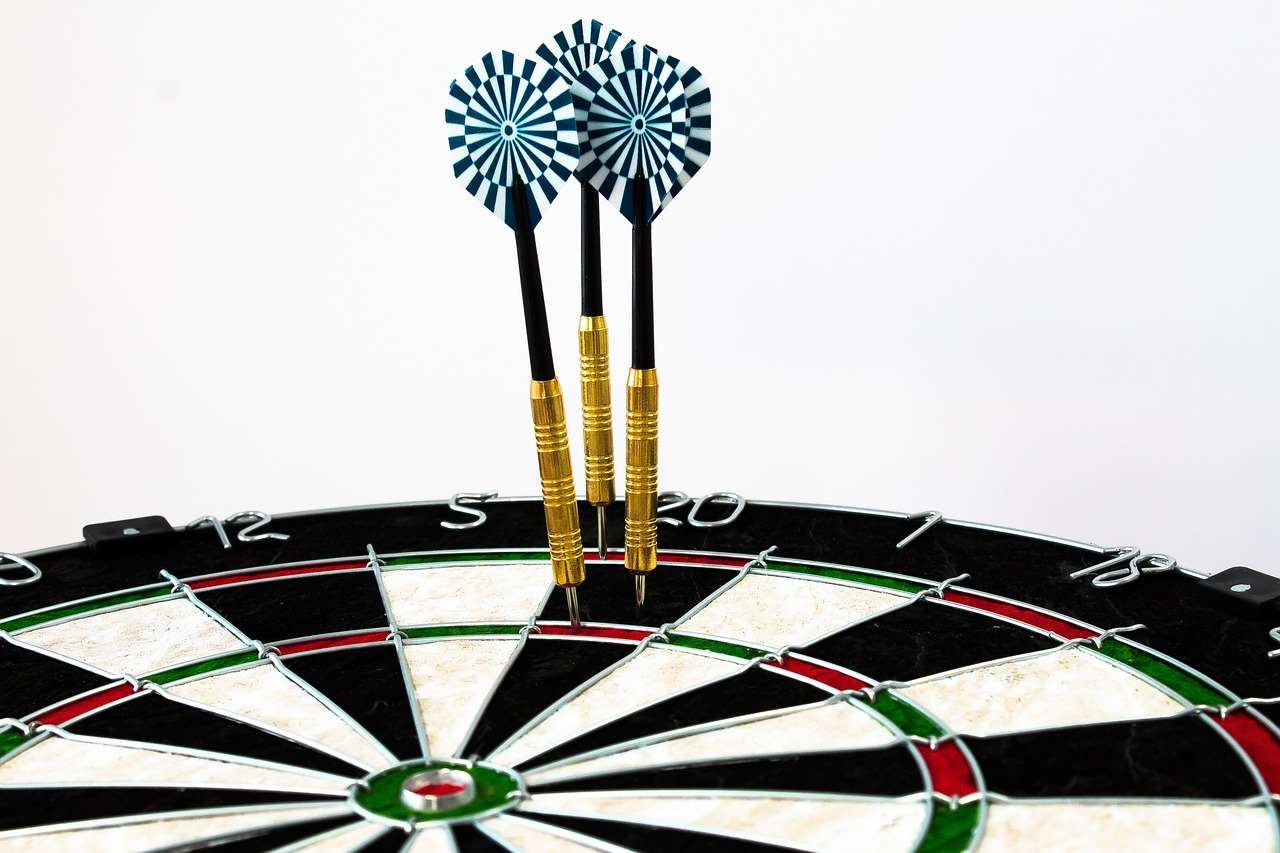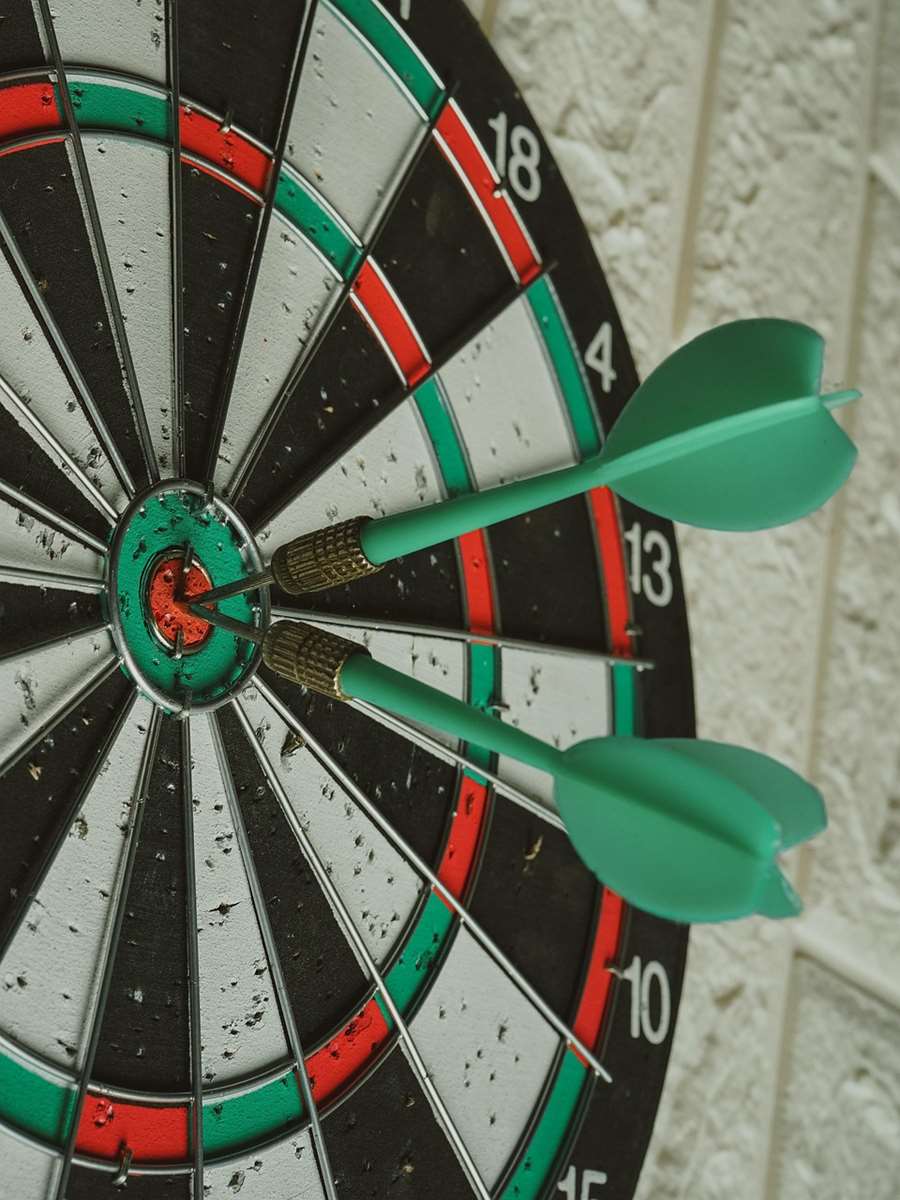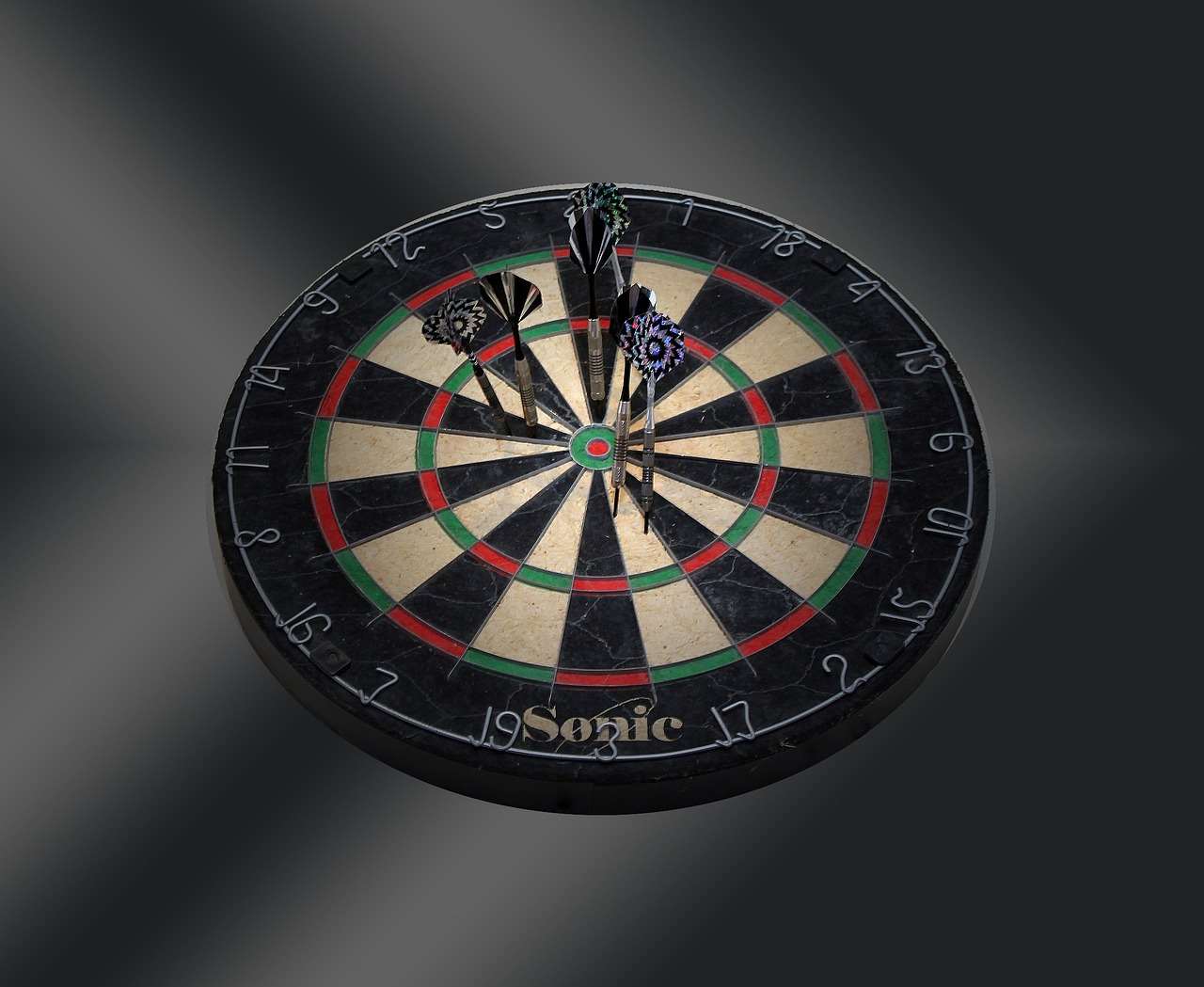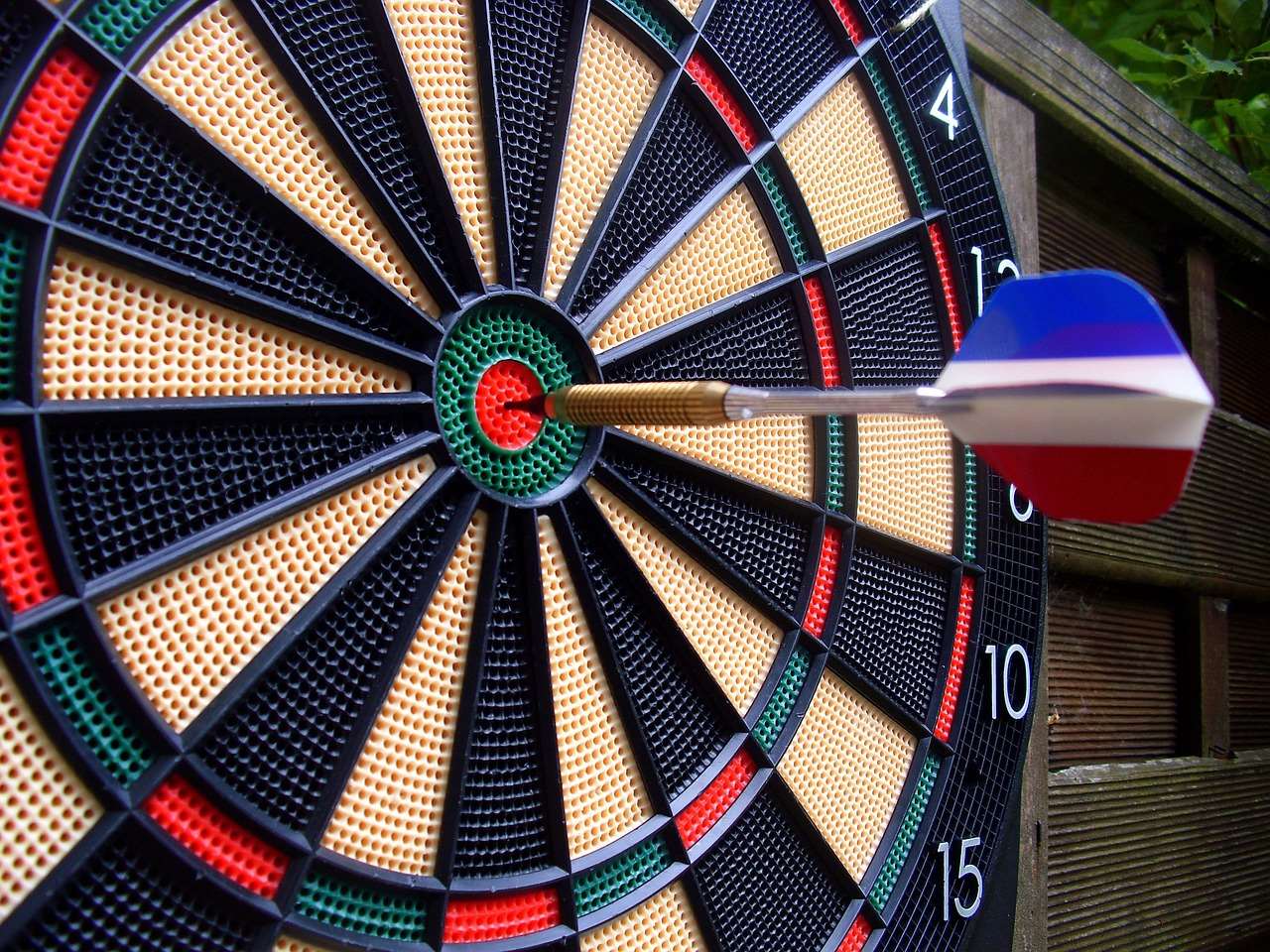The dart weight influence on wobble is significant: heavier darts tend to exhibit less wobble due to their increased stability in flight, resulting in straighter trajectories. This article will explore how dart weight, along with other factors, contributes to dart wobble and how you can optimize your setup for improved accuracy.
⚠️ Still Using Pen & Paper (or a Chalkboard)?! ⚠️
Step into the future! The Dart Counter App handles all the scoring, suggests checkouts, and tracks your stats automatically. It's easier than you think!
Try the Smart Dart Counter App FREE!Ready for an upgrade? Click above!
Understanding Dart Wobble and Its Causes
Dart wobble refers to the unwanted side-to-side or up-and-down movement of a dart during its flight toward the dartboard. Excessive wobble can lead to inconsistent landings and lower scores. While a completely wobble-free flight is nearly impossible, minimizing it is crucial for improving your dart game. Several factors contribute to dart wobble, and understanding these factors is the first step toward addressing the issue.
- Release Technique: A jerky or inconsistent release is a primary cause of dart wobble. Smooth, controlled release is essential for a stable dart flight.
- Dart Grip: An improper grip can introduce unwanted torque or spin to the dart, causing it to wobble. Experimenting with different grip styles can help you find one that promotes a straighter throw.
- Dart Weight and Balance: As we’ll explore in detail, the weight and balance of your darts significantly impact their stability in flight.
- Dart Aerodynamics: The shape and size of the flights influence how the dart cuts through the air, affecting its stability.
- Wind Conditions: Although mostly relevant for outdoor dart games, even a slight breeze can affect a light dart’s trajectory and wobble.

Many players looking to improve their equipment prefer to Choose Best Dart Equipment for the situation they find themselves in to help improve their performance.
The Dart Weight Influence On Wobble: A Deeper Dive
The **dart weight influence on wobble** is primarily due to the dart’s inertia. Inertia is the tendency of an object to resist changes in its motion. Heavier darts have greater inertia, making them more resistant to external forces that could cause them to deviate from a straight path. In other words, a heavier dart is less likely to be affected by minor inconsistencies in your throw or by air resistance.
Imagine pushing a bowling ball versus pushing a tennis ball. The bowling ball requires more force to get moving, but it’s also less likely to be easily deflected from its path. Similarly, a heavier dart requires more force to throw, but once in motion, it’s more stable and less prone to wobble. This stability translates into a more consistent trajectory and ultimately, better accuracy.
How Weight Distribution Affects Wobble
While overall dart weight is a significant factor, the distribution of that weight is equally important. Darts are generally categorized by their weight distribution: front-weighted, center-weighted, and rear-weighted.
- Front-Weighted Darts: These darts have most of their weight concentrated towards the front (point) of the dart. They tend to fly with a more direct trajectory and are often preferred by players who want a stable and consistent throw. Front weighting can help reduce wobble as the heavier front pulls the dart straight.
- Center-Weighted Darts: These darts have their weight evenly distributed throughout the barrel. They offer a balance between stability and control, making them a good choice for players who prefer a more neutral feel.
- Rear-Weighted Darts: These darts have most of their weight concentrated towards the back (flights) of the dart. They can be more forgiving of release errors but may exhibit more wobble if not thrown correctly. Rear-weighted darts are suitable for players who naturally throw with a higher arc.
Experimenting with different weight distributions can help you find the dart that feels most comfortable and provides the most stable flight for your throwing style. Consider your natural throwing motion and release point when selecting a dart with the appropriate weight distribution. Remember, even the best Best Dartboard Lighting Systems won’t save you from a poorly weighted dart.

Other Factors Contributing to Dart Wobble
While we’ve highlighted the dart weight influence on wobble, it’s crucial to understand that it’s not the only factor at play. Other elements, such as grip, stance, and throw, play a significant role.
- Grip Consistency: Maintaining a consistent grip is paramount to minimizing wobble. Any variation in your grip can introduce unwanted spin or torque, causing the dart to deviate from its intended path. Practice gripping your darts the same way every time.
- Stance and Balance: A stable stance provides a solid foundation for your throw. Ensure your weight is evenly distributed and that you’re not swaying or leaning excessively during your motion. A balanced stance promotes a more controlled and consistent release.
- Smooth Throwing Motion: A jerky or rushed throwing motion is a common cause of dart wobble. Focus on maintaining a smooth, fluid motion from your stance to your release. Practice slowing down your throw and focusing on control over power.
These components, along with environmental factors, create the circumstances for dart flights. Consider Types Optimal Dartboard Lighting so you can see where your darts are landing.
Choosing the Right Dart Weight for Your Throw
Selecting the appropriate dart weight is a personal preference based on your throwing style and feel. However, here are some general guidelines:
- Beginners: Often, beginners benefit from starting with a medium-weight dart (around 22-24 grams). This weight offers a good balance between stability and control, allowing you to develop a consistent throwing motion.
- Players with a Strong Throw: Players who tend to throw with a lot of force may prefer heavier darts (24-26 grams or more). The added weight helps control their power and reduces the likelihood of the dart veering off course.
- Players with a Softer Throw: Players with a more delicate or finesse-oriented throw may prefer lighter darts (20-22 grams or less). Lighter darts require less force to throw and can be easier to control for players with a softer touch.
It’s important to experiment with different dart weights to find what feels most comfortable and performs best for you. Don’t be afraid to try different weights and barrel shapes until you find the perfect match.

Optimizing Your Dart Setup for Reduced Wobble
Beyond dart weight, several other aspects of your dart setup can impact wobble. Here’s how to optimize your setup:
- Flight Selection: Flights come in various shapes and sizes, each affecting the dart’s aerodynamics. Larger flights provide more stability but can also slow the dart down. Smaller flights offer less stability but allow for a faster, more direct trajectory. Experiment with different flight shapes and sizes to find what works best for you.
- Shaft Length: The length of your shaft also influences the dart’s flight. Shorter shafts tend to make the dart fly straighter, while longer shafts can provide more stability. Again, experimentation is key to finding the optimal shaft length for your throwing style.
- Tighten Everything: Ensure all components of your dart are securely tightened. Loose flights or shafts can cause vibrations and wobble during flight. Regularly check and tighten all connections to maintain a stable dart setup.
The Impact of Dart Material on Wobble
The material that your dart barrel is made from can also have a subtle **dart weight influence on wobble**. While not as significant as the overall weight or weight distribution, the density of the material affects the dart’s balance and feel.
- Tungsten Darts: Tungsten is a dense metal, allowing for slimmer barrels with the same weight as bulkier brass darts. The slimmer profile reduces air resistance, potentially leading to a more stable flight and less wobble. Tungsten darts are generally preferred by serious players due to their durability and consistent performance.
- Brass Darts: Brass darts are less expensive and typically bulkier than tungsten darts. While perfectly suitable for casual play, the larger barrel profile can increase air resistance and potentially contribute to more wobble.
- Nickel Silver Darts: Nickel silver offers a middle ground between brass and tungsten in terms of price and performance. They are more durable than brass but not as dense as tungsten.
Selecting the right material is ultimately a matter of personal preference and budget. However, consider the potential impact on aerodynamics and stability when making your choice. Proper care can ensure LED Dartboard Lights Benefits are easily viewable on high-quality darts.

Practice Drills to Reduce Dart Wobble
Even with the perfect dart setup, consistent practice is crucial for reducing wobble. Here are some drills you can incorporate into your practice routine:
- The Follow-Through Drill: Focus on maintaining a consistent follow-through after releasing the dart. This helps ensure a smooth and controlled release.
- The Grip Consistency Drill: Practice gripping your darts the same way every time. Pay attention to the pressure you apply and the position of your fingers.
- The Target Practice Drill: Aim for a specific target on the dartboard (e.g., the bullseye) and focus on throwing straight and consistent darts.
Consistency is key to minimizing wobble and improving your overall accuracy. Dedicate time to practicing these drills regularly to develop a more stable and reliable throwing motion. Also, think about how to Reduce Dartboard Shadows Effectively as that can improve your practice and clarity.

Conclusion
Understanding the **dart weight influence on wobble** is crucial for any dart player looking to improve their accuracy and consistency. While heavier darts tend to exhibit less wobble due to their increased stability, other factors such as weight distribution, grip, throwing motion, and dart setup also play significant roles. By experimenting with different dart weights and configurations, refining your technique, and practicing consistently, you can minimize wobble and unlock your full dart-playing potential.
Ultimately, the best way to reduce dart wobble is to find the dart and throwing style that works best for you through experimentation and dedicated practice. Now, go out there, experiment with your setup, and refine your technique to achieve straighter, more consistent throws. Don’t be afraid to try something new to find your unique style and see if cabinet Cabinet Lighting For Dartboards or another adjustment helps your performance.
Hi, I’m Dieter, and I created Dartcounter (Dartcounterapp.com). My motivation wasn’t being a darts expert – quite the opposite! When I first started playing, I loved the game but found keeping accurate scores and tracking stats difficult and distracting.
I figured I couldn’t be the only one struggling with this. So, I decided to build a solution: an easy-to-use application that everyone, no matter their experience level, could use to manage scoring effortlessly.
My goal for Dartcounter was simple: let the app handle the numbers – the scoring, the averages, the stats, even checkout suggestions – so players could focus purely on their throw and enjoying the game. It began as a way to solve my own beginner’s problem, and I’m thrilled it has grown into a helpful tool for the wider darts community.